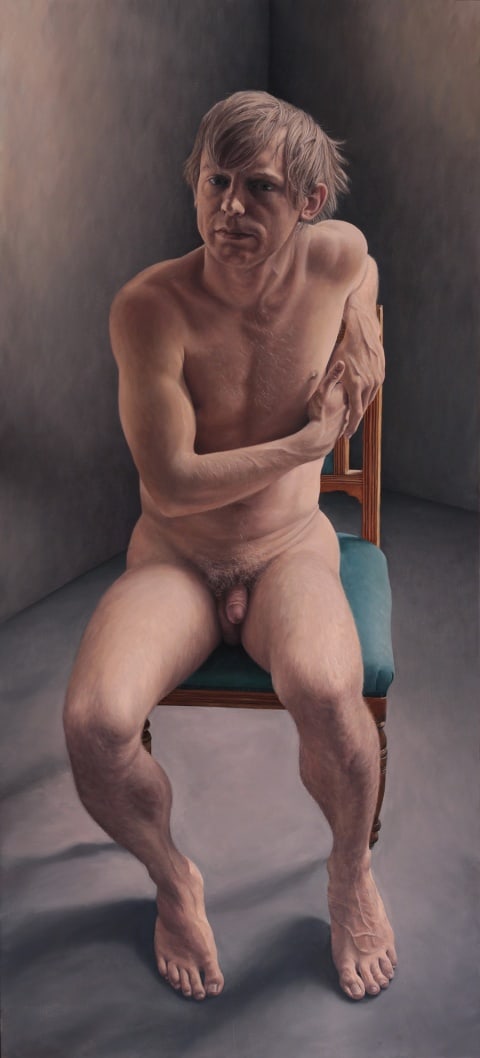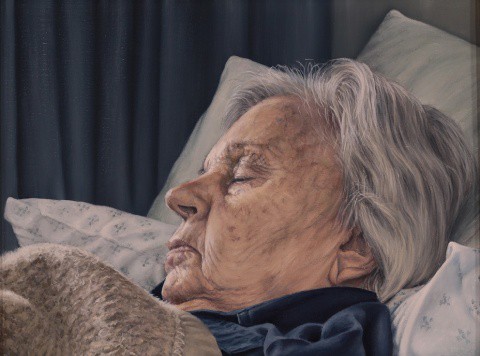Winner of the SPI National Portrait Awards
Ashraf Jamal Interviews Heather Gourlay-Conyngham
Heather Gourlay-Conyngham: The scale of the two paintings differs in that Mom Sleeping portrays part of the figure while A Young Man depicts the full figure. But the scale of the figures themselves is the same: they are both life size, the scale in which I prefer to paint.
The juxtaposition of these particular paintings emphasises the subjects’ age difference. However, it is true that I am interested in the effects of the passage of time. Capturing age is not a challenge in itself but is integral to the overall challenge of painting. My art reflects a subjective view which is, inevitably, determined by my own age at the time of executing the particular work.
I was 56 and my mother 87 when I painted Mom Sleeping, so it is natural that, relative to myself, I saw her as an old woman, nearing the end of her life. At the time, I was spending many hours sitting at her bedside in a clinic while she recovered from an operation. Contemplation of her age and mortality was a natural part of this scrutiny, as was my need to record the beauty I perceived.
The same can be said of my need to paint A Young Man, which I was working on when I turned 57. The fact that I am of a different generation from the model must surely allow me to see more clearly the innate vigour, tension and, again, exquisite beauty, that comes with youth.
2) AJ: Do you think that youth is wasted on the young?
HGC: Until the end of 2011 I had been a teacher at secondary-school level almost consistently since 1980 and there were many times when I cracked the whip to get pupils to be productive and not to waste time. But now that I’m no longer dealing with adolescents on a daily basis, the answer to your question is no, because I realise that “wastefulness” is an essential part of being young.

3) AJ: In A Young Man the figure gazes directly at the viewer, while in Mom sleeping the figure lies askance, withdrawn from the viewer’s gaze. Can you talk about these choices, and tell us about the different sensations you experience as a painter when connecting in such different ways with your subjects.
HGC: The subject’s gaze is always important when I plan a painting because it has such a crucial bearing on how the viewer relates to the figure. But I’ll refer to myself as both the artist and viewer in answering your question.
I wanted the young man to look directly at the viewer in order to simultaneously connect and challenge. I like the tension and energy, as well as the vulnerability that is created because the figure is revealed, but, at the same time, there is the suggestion of the subject’s impatient withdrawal from the observer.
On the other hand, Mom Sleeping suggests self-containment. The figure is oblivious of being observed, and the viewer is free to look unselfconsciously. In the context of your question, perhaps I chose this viewpoint because I don’t yet know what it feels like to be 87. I was just the daughter-observer.
4) AJ: Let’s talk about the skills involved in painting…. at what point do you think or feel that a painting is finished?
HGC: I seldom know when a painting is finished and would probably still be working on A Young Man if I hadn’t decided to submit it for the SPI Award. I don’t think I ever tell myself that I have made the final brush stroke. Sometimes I begin a new painting to stop myself from working on the previous one. Perhaps my readiness to take this step is a signal that the previous work is finished.
5) AJ: How preoccupied are you with realism, or capturing what you regard as realistic?
HGC: Realism is difficult to define. If we are talking about mirroring the natural world, I am not much concerned with copying visual reality and have no desire to be a photo-realist. However, I use real people as models as well as a photographic reference in my work. Although it is not evident in the two paintings we are discussing, much of my work has a lyrical quality – real objects juxtaposed in a familiar but sometimes unreal (but not surreal) manner. There is distortion in my work although it is not necessarily evident. For instance, I always use multiple photographs for reference as well as sittings and, in the case of A Young Man, two models were used, although one far more than the other. Having said that, I need to feel that the final work has a certain visual logic which, in the case of the figure, is anatomically “correct” and pleasing to the eye.

6) AJ: Is there a difference in your view between realism and truth?
HGC: This is another difficult question because the two are so intertwined. If we are to understand “truth” as artistic integrity, something which I feel is crucial for the creation of an artwork, it may be distinguished from visual realism. On the other hand, realism may refer to the artist’s personal reality, something akin to the interpretation of “truth” as integrity. It is not important for me to depict what I see at face value, but rather what lies beneath the surface, or how visual reality is refracted through my own perceptions.
7) AJ: How much of the story you are conveying is evident in the physicality of the painting, and how much is intuited by the viewer? In other words, what, in your view, sums up the “content” of a painting?
HGC: Hopefully the physicality of the painting will serve as the seed that sparks thoughts in the mind of the observer. In many ways this is what gives a painting a life of its own. It’s a bizarre concept that something as basic as pigment on a surface constitutes the physical link between the artist and viewer, but what is communicated with these materials is an integral part of the content. I try not to over-state the story in my art and was particularly conscious of doing so in the paring of A Young Man. I was aware that, in the process of simplifying the subject-matter – that is, the removal of all possible props – the content of the work was becoming more complex. There may be viewers who feast their eyes on the undeniable physical beauty of the young man but others may discover that there is an intangible element too. I don’t expect the viewer to reiterate my intentions but it’s a pleasant surprise and a privilege when it happens.
8) AJ: Returning to skill: do you feel that you have mastered the craft of painting?
HGC: No, not at all and I hope I never will, because I imagine that would result in the act of painting becoming very boring and formulaic. Because I have painted for so long, I have obviously honed the skill while developing a method that suits my needs but I am constantly making adjustments and trying out new things.
9) AJ: Do you only paint portraits? Do you prefer “capturing” people?
HGC: I have always preferred to paint people but see myself as having two basic themes. Firstly, there are portraits in which a concept will be developed or determined by a particular person who has captured my imagination. Secondly, a concept will determine the use of a figure who serves as a means in my self-expression.
10) AJ: What does it mean to be human?
HGC: I can’t answer this, Ashraf! It is too difficult! Could it have something to do with being able to relate to others; seek to understand and be understood; make sense of the world and attempt to make a positive contribution to life; the desire to be immortalised?
11) AJ: Do you care for your fellow humans?
HGC: Yes, a great deal. I hope I am an empathetic person. Teaching has taught me to respect individuals and to see people as inherently equal. I try not to be judgemental but this is not to say I love all people. On the contrary, I am repelled by aspects of human behaviour, such as prejudice, conceit, greed and dishonesty.
12) AJ: When you walk through the world – what do you see? What captures your imagination?
HGC: I see order and patterns as well as their disruption in both the natural and human-made world. I think Art History has helped me to look critically at the appearance of things and the role people have played in bringing this about. For instance, I have learnt much about human values from looking at the development of Western art and architecture. But on a more personal level, I enjoy observing people, both those close to me and strangers. They are infinitely fascinating.
13) AJ: Do you think the imagination is an important aspect of being an artist? Or do you feel it is a minor dimension, secondary to the powers of observation, concentration, and sheer ability?
HGC: I think there should be a balance between imagination, observation and the skill necessary to express both. Imagination is crucial – without it there can be no real creativity. Laborious imitation of what is being observed must be distinguished from an imaginative elevation of even the most mundane.
14) AJ: Now that you are the first winner of this prestigious award – what are you going to do with the money?!
HGC: For the past few months I have been have been dipping heavily into my modest pension to have a studio built. The prize will help to replenish the coffers.
15) AJ: What is your next painting project?
HGC: I can’t wait to move into my new studio and get on with painting. I have a canvas stretched and waiting, probably for another male nude.
16) AJ: Are you planning on a solo show?
HGC: Last year I had two solo shows, both entitled Unfoldings, the one a retrospective-type show at the Tatham Art Gallery in Pietermaritzburg and the other at the KZNSA Gallery in Durban. I need to build up a portfolio of new work. There are exciting plans afoot for exhibitions in which my work will be included, as well as another solo show.
17) AJ: What, in your view, is the power of portraiture?
HGC: There is something compelling about recording a person for posterity. Not only does a portrait give insight into a particular person but it gives a sense of the time in which he/she lived as well as the way the artist perceived that person. It is human nature to look at people and, although it may take new and currently unimagined forms, it is unlikely that portraiture will ever cease.
18) AJ: Do you think that painting is a vital dimension of human civilization?
HGC: Although it has existed for aeons I don’t think that painting per se is necessarily a vital dimension of civilization. But visual communication is and painting is one means of doing so.
19) AJ: Do you think that painting other humans is an essential aspect of being you?
HGC: Yes…see Ques 9. Painting is part of my being and whatever I choose to paint, somehow a human finds its way into the composition.
20) AJ: Tell us something which we as readers and admirers don’t know about you, but which you feel we should.
HGC: I’ve been told I am secretive.



